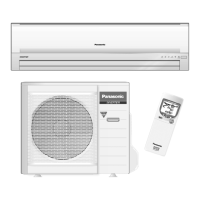5. When installing or transferring an AC, follow the instructions in
the installation instructions carefully. Incorrect installation can
result in an abnormal refrigeration cycle or water leakage, electric
shock, fire, etc.
6. Do not perform any alterations on the AC unit under any
circumstances. Have all repair work done by a specialist.
Incorrect repairs can result in an water leakage, electric shock,
fire, etc.
10.2. TOOL FOR INSTALLING / SERVICING REFRIGERANT PIPING
10.2.1. Necessary Tools
In order to prevent an R410A AC from mistakenly being charged with any other refrigerant, the
diameter of the 3-way valve service port on the outdoor unit has been changed. Also, to
increase its ability to withstand pressure, the opposing dimensionshave been changed for the
refrigerant pipe flaring size and flare nut. Accordingly, when installing or servicing refrigerant
piping, you must have both the R410A and ordinary tools listed below.
Table 3 Tools for installation, transferring or replacement
Type of work Ordinary tools R410A tools
Flaring Flaring tool (clutch type), pipe
cutter, reamer
Copper pipe gauge for
clearance Adjustment, flaring
tool (clutch type)*1)
Bending, connecting pipes Torque wrench(nominal
diameter 1/4, 3/8,1/2) Fixed
spanner(opposing sides 12
mm, 17 mm, 19 mm)Adjustable
wrench, Spring bender
Air purging Vacuum pumpHexagonal
wrench(opposing sides 4 mm)
Manifold gauge, charging
hose,vacuum pump adaptor
Gas leak inspection Gas leak inspection fluid or
soapy water
Electric gas leak detector for
HFC refrigerant*2)
*1) You can use the conventional (R22) flaring tool. If you need to buy a new tool, buy the R410A
type.
*2) Use when it is necessary to detect small gas leaks.
For other installation work, you should have the usual tools, such as screwdrivers (+,-), a metal-
cutting saw, an electrical drill, a hole core drill (65 or 70 dia.), a tape measure, a level, a
thermometer, a clamp meter, an insulationtester, a voltmeter, etc.
Table 4 Tools for serving

